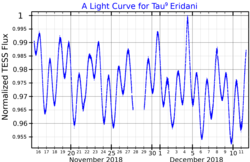Astronomy:Tau9 Eridani
Tau9 Eridani (τ9 Eri) is a binary star in the constellation Eridanus. It is visible to the naked eye with an apparent visual magnitude of 4.63.[3] The distance to this system can be estimated using the parallax method, which yields a value of roughly 327 light years.[3]
This is a double-lined spectroscopic binary system with an orbital period of 5.95382 days and an eccentricity of 0.12.[7] The primary component, τ9 Eri A, is a magnetic chemically peculiar star[10] with a stellar classification of B9.5V Si,[4] indicating that it is a B-type main sequence star that shows abundance anomalies in its silicon absorption lines.[4] It is an Alpha² Canum Venaticorum variable[5] with a rotational periodicity of 5.954 days.[11] The averaged strength of the stellar effective magnetic field is 240.6±91.0 G.[4]
The primary component Tau9 Eridani A has an estimated 326%[10] the mass of the Sun and 3.1 times the Sun's radius.[8] It shines with 166[12] times the solar luminosity from an outer atmosphere at an effective temperature of 10,866 K.[12] The star is spinning with a projected rotational velocity of 30 km/s.[13] The secondary star, designated Tau9 Eridani B, is a late A-type or early F-type star with a mass of 1.6 solar masses and an effective temperature of 7530 K.[7]
References
- ↑ "MAST: Barbara A. Mikulski Archive for Space Telescopes". Space Telescope Science Institute. https://mast.stsci.edu/portal/Mashup/Clients/Mast/Portal.html.
- ↑ 2.0 2.1 2.2 2.3 2.4 van Leeuwen, F. (2007), "Validation of the new Hipparcos reduction", Astronomy and Astrophysics 474 (2): 653–664, doi:10.1051/0004-6361:20078357, Bibcode: 2007A&A...474..653V.
- ↑ 3.0 3.1 3.2 3.3 3.4 Mermilliod, J.-C. (1986), "Compilation of Eggen's UBV data, transformed to UBV (unpublished)", Catalogue of Eggen's UBV Data (SIMBAD), Bibcode: 1986EgUBV........0M.
- ↑ 4.0 4.1 4.2 4.3 Bychkov, V. D. et al. (April 2009), "Catalogue of averaged stellar effective magnetic fields - II. Re-discussion of chemically peculiar A and B stars", Monthly Notices of the Royal Astronomical Society 394 (3): 1338–1350, doi:10.1111/j.1365-2966.2008.14227.x, Bibcode: 2009MNRAS.394.1338B.
- ↑ 5.0 5.1 5.2 Dubath, P. et al. (2011), "Random forest automated supervised classification of Hipparcos periodic variable stars", Monthly Notices of the Royal Astronomical Society 414 (3): 2602–2617, doi:10.1111/j.1365-2966.2011.18575.x, Bibcode: 2011MNRAS.414.2602D.
- ↑ De Bruijne, J. H. J.; Eilers, A.-C. (2012), "Radial velocities for the HIPPARCOS-Gaia Hundred-Thousand-Proper-Motion project", Astronomy & Astrophysics 546: A61, doi:10.1051/0004-6361/201219219, Bibcode: 2012A&A...546A..61D.
- ↑ 7.00 7.01 7.02 7.03 7.04 7.05 7.06 7.07 7.08 7.09 7.10 7.11 7.12 7.13 Woodcock, K. (2021), "τ9 Eri: a bright pulsating magnetic Bp star in a 5.95-d double-lined spectroscopic binary", Monthly Notices of the Royal Astronomical Society 502 (4): 5200–5209, doi:10.1093/mnras/stab338, Bibcode: 2021MNRAS.502.5200W
- ↑ 8.0 8.1 North, P. (June 1998), "Do SI stars undergo any rotational braking?", Astronomy and Astrophysics 334: 181–187, Bibcode: 1998A&A...334..181N.
- ↑ "tau09 Eri". SIMBAD. Centre de données astronomiques de Strasbourg. http://simbad.u-strasbg.fr/simbad/sim-basic?Ident=tau09+Eri.
- ↑ 10.0 10.1 Shulyak, D. et al. (September 2014), "Interferometry of chemically peculiar stars: theoretical predictions versus modern observing facilities", Monthly Notices of the Royal Astronomical Society 443 (2): 1629–1642, doi:10.1093/mnras/stu1259, Bibcode: 2014MNRAS.443.1629S.
- ↑ Bychkov, V. D. et al. (February 2005), "A catalog of stellar magnetic rotational phase curves", Astronomy and Astrophysics 430 (3): 1143–1154, doi:10.1051/0004-6361:20034563, Bibcode: 2005A&A...430.1143B.
- ↑ 12.0 12.1 McDonald, I. et al. (2012), "Fundamental Parameters and Infrared Excesses of Hipparcos Stars", Monthly Notices of the Royal Astronomical Society 427 (1): 343–57, doi:10.1111/j.1365-2966.2012.21873.x, Bibcode: 2012MNRAS.427..343M.
- ↑ Abt, Helmut A. et al. (July 2002), "Rotational Velocities of B Stars", The Astrophysical Journal 573 (1): 359–365, doi:10.1086/340590, Bibcode: 2002ApJ...573..359A.
 |


